Local theater news
The old Regal Hollywood Cinema 14 will have its grand re-opening this Friday, June 5, as the Carolina Asheville Cinema 14. Changes abound. There’s a new lobby with a kind of screening-room mezzanine where the video games used to be. There are new seats, equipment upgrades—including one digital theater that will allow the Carolina to run digital 3-D, which brings the area total up to six (one at Carolina, one at the Epic in Hendersonville, one at the Biltmore Grande and three 3-D houses at the Carmike 10.)
Perhaps even more enticing is the Carolina’s change in programming, which has resulted in them booking such exclusive movies for their opening weekend as Rian Johnson’s The Brothers Bloom and Jan Troell’s Everlasting Moments, as well as bringing in Johnson’s first film, Brick, which didn’t play here when it was released in 2006. (All three are reviewed in this Wednesday’s Xpress.) There are more programming changes in the offing, but I can say nothing about those just yet. I’ll get back to you.
New in theaters
What a tasty week this is proving to be. Oh no, I don’t mean Will Ferrell in Land of the Lost, Todd Phillips’ The Hangover or even Nia Vardolos’ attempt to recapture her My Big Fat Greek Wedding audience with My Life in Ruins, though I’m sure there’s an audience for all three. (You know who you are.) I’m looking more at the slightly less mainstream fare that abounds this week.

Not only do we get The Brothers Bloom (my favorite film of the year to date), Everlasting Moments and Brick at the Carolina, but the Fine Arts is bringing us the darkly comic Lymelife with Alec Baldwin and the highly praised sports drama/character study Sugar, while holding on to Michael Caine in Is Anybody There? for one show a day. The last named becomes a must-see, if only for Caine’s brilliant performance and the chemistry between Caine and Bill Milner (the kid from Son of Rambow).
The marvelous Sunshine Cleaning is still holding on for two shows a day at the Carmike 10. If you haven’t seen this one, I strongly recommend you do. Of course, Up is still with us, and it’s in the must-see column. It’s around in two formats: 3-D and 2-D. (The Carolina, the Epic and the Biltmore Grande have one 3-D print each, and there are two screens of it at the Carmike.) This is a film where I really suggest you go for the 3-D version. Oh, it’s still a wonderful and remarkable film in either version, but the 3-D one adds an extra layer of visual impact—and it does so without the usual “comin’ at you” 3-D tricks. Up simply uses the process to give the film depth. It’s intelligent and it doesn’t seem—for me anyway—to induce eyestrain.
Most of the big summer titles are also still around, too, and if you’re determined to catch them, you might want to consider doing so before the next wave of big summer titles that are waiting in the wings.
Noteworthy DVD releases
The richness of the theatrical offers is, alas, not matched by the new DVD releases—at least not in the mainstream realm. Both Sam Mendes’ Revolutionary Road and Ed Zwick’s Defiance bellied up at the box office (the latter spectacularly) and failed in their bids as Oscar bait. All the same, they’re hitting the DVD shelves this week. I don’t plan on revisiting them, nor am I thrilled by He’s Just Not That Into You, which I wasn’t that into on the big screen. Apart from another DVD release of Bruce Beresford’s Tender Mercies (does this make four?), my ennui for DVDs coming our way is boundless. And there’s nothing worse than boundless ennui, I can tell you—except galloping malaise and I’m holding up against that. Hopefully Marc from Orbit will stop by with news of esoterica.
Notable TV screenings
Fox Movie Channel continues its run of the same old movies. Come on, guys, I know there are more things in that vault than Jumpin’ Jack Flash, How I Got Into College, Home Alone and Revenge of the Nerds II. That sounds like an overstatement, and it is one, but it captures the flavor of what FMC is offering most of the time these days.
Turner Classic Movies, on the other hand, has turned over the month of June to what they’re calling their “Great Directors” series. TCM and I have some serious definitional differences on who qualifies as great directors, I’ll admit. John Sturges and Sam Wood (Sam Wood?) don’t even make also-ran status for me. Moreover, we often part company on representative choices. (Their Ernst Lubitsch set later this month is pretty lame and overlooks the maestro’s richest period altogether.) A lot of this, of course, is based on economics and what they have the rights to, so I’m willing to cut them some slack (but again, Sam Wood??). Plus, the idea is a good one—as long as you approach it with some caution. In other words, the choices aren’t definitive in any sense. That’s true of both directors and the individual examples. However, as a kind of primer on directors, it amounts to a month-long crash course in filmmaking. That’s pretty hard to fault in a general sense. So let’s look over a few of this week’s offerings.
King Vidor Wednesday, June 3, starting at 8 p.m.
The Crowd (1928), The Champ (1931), Duel in the Sun (1946), The Fountainhead (1949) and Our Daily Bread (1934)
There’s no doubt that King Vidor qualifies as a great director, and this is actually a pretty interesting—even provocative—collection of his work. The Crowd is one of the essential silent movies. The Champ is a film I’ve waxed ecstatic about several times—most recently in the Screening Room about movies that make you cry. Well, here’s a chance to see if it has that effect on you.
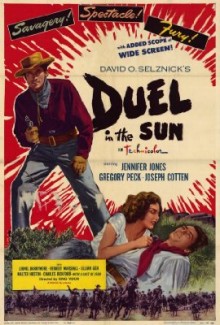
Duel in the Sun is unregenerate, overheated trash. It’s way too long at 144 minutes. It’s impossibly vulgar—even its colors are vulgar—and it’s on the unintentionally funny side with its preposterous (not to mention clichéd) ending. The acting is overstated. Well, that often happens with Jennifer Jones, but the rest of the cast, including Gregory Peck, seems to have followed her lead. The whole thing revolves around Jones as an improbable half-breed, who drives two brothers—one good (Joseph Cotten), one bad (Peck)—nigh on to mad with lust. It’s no surprise that Jones’ husband, David O. Selznick, produced this fascinating abomination. Lionel Barrymore and Lillian Gish are also on hand, while Orson Welles offers the ponderous narration. Vidor signed the film, but six other directors and Selznick took turns at cranking it out. It seems an awful lot of effort for the results, but it hardly lacks for interest.
The jaw-dropper here is the pairing of The Fountainhead and Our Daily Bread—two movies that you couldn’t put in the same room without bloodshed. The Fountainhead is, yes, adapted from Ayn Rand’s novel and the screenplay is by Ms. Rand herself, which means it more or less finds her 10 percent fascinating, 90 percent crackpot philosophy intact. Vidor wasn’t impressed by the book or the screenplay or the philosophy, so he immersed himself in the story’s overheated sexuality and the opportunities it afforded for rampant stylization. The Randian nonsense is still there, but you’re far more likely to come away remembering the visuals, Gary Cooper’s biceps and the world’s most phallic ending.
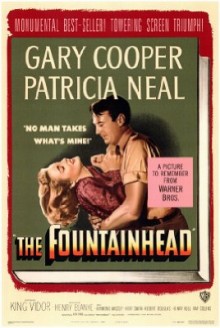
Putting Rand’s objectivist screed up against Vidor’s Our Daily Bread is a study in opposites, since the 1934 film—about a Depression couple who inherit a farm and turn it into a collective—is sufficiently communist-minded that it almost might be a Soviet film. Vidor made the film on a shoestring, and it’s a much more personal project than The Fountainhead. Unfortunately, it’s nearly as silly in other ways, because the only thing Vidor seems to have been able to interject drama into the film was to bring in a floozie from the city to cause the hero to stray from his path. That might work in a romantic film like F.W. Murnau’s Sunrise (1927)—come to think of it, it did work there—but here it’s cheesy melodrama and it undermines the movie, though not fatally. The climactic sequence involving the completion of an irrigation system to save the crops used to serve as a film-school staple of how to edit a film. It’s still pretty impressive.
Sam Wood Thursday, June 4, starting at 6 a.m.
The Stratton Story (1949), King’s Row (1942), Casanova Brown (1944), Kitty Foyle (1940), Goodbye Mr. Chips (1939), The Devil and Miss Jones (1941) and A Day at the Races (1937)
No, Sam Wood is not one of the great directors, but his name is on a few very good films—or at least very well-known ones. That they’re still around has less to do with Wood than with other factors. Wood was a studio man, an OK craftsman with no discernible style or point. He’s the man who became famous for directing the Marx Brothers by telling the boys, “Get out there and sell them a load of clams,” before every take. The beauty of the studio system lay in the fact that the rest of the technical crew could take up the slack in a case like this, so Wood’s bland competence was satisfactory.
There are some interesting movies here. King’s Row—famous for Ronald Reagan getting his legs amputated by a sadistic doctor with a God complex—is almost subversive in its portrait of small-town Americana as a hotbed of mental illness, dark secrets, suicides, murders and unnecessary surgeries. It’s kind of the Blue Velvet of its day, though it seems unlikely that Wood got that, since it plays like a roseate bit of nostalgia. Goodbye Mr. Chips isn’t bad, but that’s mostly due to the performances of Robert Donat and Greer Garson.
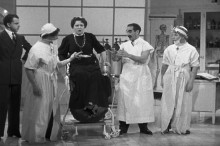
The Devil and Miss Jones is a pleasant diversion that again owes much to its cast, and while A Day at the Races is the last really good Marx Brothers film, that has little to do with Wood having them sell a load of clams. The best that can be said is that he didn’t interfere. It can also be argued that Wood wasn’t responsible for the ever-encroaching MGM-ification of the boys with attempts at making them more and more sympathetic and palatable to the mainstream. It’s a kind of negative glory that the worst that can be said of Wood in this regard is that he just happened to be there while it was happening. Actually, that kind of sums up his career.
Ingmar Bergman Thursday, June 4, starting at 8 p.m.
The Seventh Seal (1957), Wild Strawberries (1958), Persona (1966), Hour of the Wolf (1968) and The Passion of Anna (1969)
I don’t suppose the irony of following Sam Wood with Ingmar Bergman is deliberate, but it’s certainly there! I’m not sure it would be possible to find two more dissimilar spirits. I’m also not going to go into Bergman’s films here. You can find reviews for four of them in the Xpress movie archives and I’ve somehow never seen Hour of the Wolf, which I hope to rectify with this showing.
I will at least note that if you were to simply watch the first three films in this set, you’ll have seen one of the greatest of all filmmakers at the top of his game.
Carol Reed Friday, June 5, starting at 6 a.m.
The Key (1958), The Running Man (1963), Our Man in Havana (1960), The Agony and the Ectsasy (1965), The Man Between (1953), The Fallen Idol (1948) and The Third Man (1949)
Carol Reed—or Sir Carol Reed—is the great British classicist. He was Britain’s great filmmaker who, unlike Hitchcock, did not succumb to Hollywood. Unfortunately, Reed tends to get shunted to one side in favor of the epic grandeur of David Lean and the personal quirkiness of Michael Powell. As a result, although he is responsible for one of the most nearly perfect movies ever made—The Third Man—he really doesn’t get the respect he should. The fact that he helmed such ponderous fare as The Agony and the Ecstasy doesn’t help, nor is the bloated musical Oliver! likely to win him any converts.
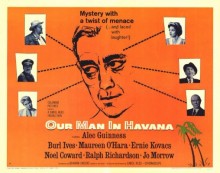
But to watch a film like The Third Man is to see a great artist at work. Or give his greatly undervalued Our Man in Havana a try. It’s very nearly as stylish. It’s certainly the last word in dry humor (the presence of Noel Coward adds to that) and it’s splendidly acted. Plus, any film where Burl Ives gives a complex, credible and likable performance is doing something very right indeed. The satire on politics and political espionage is remarkable for 1960, and seems like a template for the even more bitter John Boorman film The Tailor of Panama (2001).
Michael Powell Tuesday, June 9, starting at 6 a.m.
I Know Where I’m Going! (1945), The Edge of the World (1937), A Canterbury Tale (1944), Night Ambush (1957), A Matter of Life and Death (1947), The Tales of Hoffman (1951) and The Life and Death of Colonel Blimp (1943)
Michael Powell—usually teamed with the nearly forgotten Emeric Pressburger—is one of film’s most unbelievable characters. He was capable of creating a wholly personal cinema at a time when such things basically just weren’t done. His films are fast-moving, but inclined to length. They’re strikingly visual. His use of color is as remarkable today as it was in the 1940s. The complete stylization evident in his work is completely at odds with the time in which he worked. Somehow he was allowed to make films on artistic subjects (a dirty word in the movie industry). But the most amazing thing about Powell is that his films are still strikingly modern. To watch his 1943 film, The Life and Death of Colonel Blimp, is to have your eyes opened. Powell was using jump-cuts while Jean-Luc Godard was going through puberty.
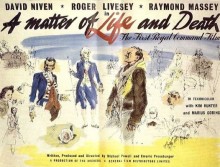
This grouping eschews the most famous of his films, The Red Shoes (1948), but it seems churlish to complain, since it does contain the delightful—and very often overlooked—I Know Where I’m Going!, which is a nonstop parade of absolutely stunning creativity. I do not believe there is an indifferent shot in the entire film. Factor in the fantasy A Matter of Life and Death and Colonel Blimp and it’s a pretty grand day of movies.
These are by no means the only directors feted in this week’s set. You’ll also find blocks of films by William Wyler, Steven Spielberg, Fritz Lang (American period only), Stanley Donen, and Michael Curtiz. Definitely worth your while.




Well, for us the biggest release for June will be WEEDS Season 4, which comes out today. The show has gotten progressively darker, but still has a lot of fans. PRISON BREAK Season 4 is also out today.
Also out is the interesting documentary HIPPIE MASALA, which follows children of the 60s who went to India for enlightenment but never left. GRINDHOUSE DOUBLE FEATURE has two late 70s sleaze: PUNK ROCK and PLEASURE PALACE. PUNK ROCK takes you to the bowels of NYC during around 1977, which is cool to see. We’re big Shaw Brothers fans, and it’s nice seeing packages like LEGENDARY HEROES get such a nice treatment. UNE FEMME MARIEE is a mid-60s Godard. THE BUTTERFLY TATTOO is an Oxford twist on Romeo & Juliet written by the same author as THE GOLDEN COMPASS.
Many more, but I need a nap…
This is why I like for you to stop in. You’re much more likely to have your finger on the offbeat.
Well, I just watched THE RED SHOES this week and A MATTER OF LIFE AND DEATH a month or so ago, so it will be nice to catch up to COLONEL BLIMP and I KNOW WHERE I’M GOING!
Thanks to Criterion, I’m now a huge fan of Powell. I had only seen PEEPING TOM before.
It’s not that long since I first saw I Know Where I’m Going! and I really wasn’t planning on watching it. In fact, I saw it only because I don’t know how to set the timer on DVD recorder, so I recorded a block of TCM onto its hard-drive. When I was going through this supposedly extraneous material, I happened to watch I Know Where I’m Going‘s opening credits and thought, well, that’s certainly clever. So I watched a little bit more and it became more fascinating all the while. I ended up watching the whole thing, of course — and I burned it to disc rather than just deleting it.
The moral of the story is don’t just assume that a film won’t interest you based on its title and a plot synopsis.